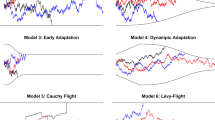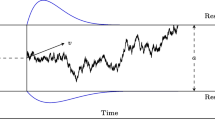Abstract
The circular drift-diffusion model (CDDM) is a sequential sampling model designed to account for decisions and response times in decision-making tasks with a circular set of choice alternatives. We present and demonstrate a fully Bayesian implementation and extension of the CDDM. This development allows researchers to apply the CDDM to data from complex experiments and draw conclusions about targeted hypotheses. The Bayesian implementation relies on a custom JAGS module. We describe the module and demonstrate its adequacy through a simulation study. We then illustrate the advantages of the implementation by revisiting data from a continuous orientation judgment task. We develop a graphical model for the analysis that is based on the CDDM but extends it with hierarchical and latent-mixture structures. We then demonstrate how these extensions are used to accommodate the design of the experiment and to implement psychological assumptions about individual differences, the difficulty of different stimulus conditions, and the impact of cues on decision making. Finally, we demonstrate how the computational Bayesian inference enabled by JAGS allows these assumptions to be tested and addresses psychological research questions about people’s decision making.










Similar content being viewed by others
Availability of Data and Materials
The data set from Kvam (2019) is available on the Open Science Framework at https://osf.io/px274/.
Code Availability
The jags-cddm module is available at https://github.com/joachimvandekerckhove/jags-cddm. Code for the application is available at https://github.com/ManuelVU/application-jags-cddm.
Notes
For computational reproducibility, the GitHub repository also includes instructions for setting up a virtual machine—a curated computational environment—that includes an operating system with appropriate compilers and software versions that support the module.
The bottom right panel of Fig. 5 excludes cases where the drift length \(\delta \) true value was close to 0 (i.e., \(\delta = 0.01\)), as the drift angle is unidentified in that case.
Other assumptions are possible, such as drift angle being some weighted combination of cue and stimulus information. While these more complicated possibilities could certainly be implemented, we consider just the simplest case in which the drift angle is determined by one or the other.
References
Baribault, B., & Collins, A. G. E. (2023). Troubleshooting Bayesian cognitive models. Psychological Methods. https://doi.org/10.1037/met0000554
Cox, R. T. (1961). The algebra of probable inference. Baltimore, MD: Johns Hopkins University Press. https://doi.org/10.56021/9780801869822.
Gelman, A., Carlin, J. B., Stern, H. S., Dunson, D. B., Vehtari, A., & Rubin, D. B. (2013). Bayesian data analysis. USA, New York: Taylor & Francis, 3rd edition. https://doi.org/10.1201/b16018.
Guan, M., & Lee, M. D. (2018). The effects of goals and environments on human performance in optimal stop** problems. Decision, 5(4), 339–361. https://doi.org/10.1037/dec0000081
Guan, M., Stokes, R., Vandekerckhove, J., & Lee, M. D. (2020). A cognitive modeling analysis of risk in sequential choice tasks. Judgment and Decision Making, 15(5), 823–850. https://doi.org/10.1017/S1930297500007956
Jaynes, E. T. (2003). Probability theory: The logic of science. Cambridge, UK: Cambridge University Press. https://doi.org/10.1017/CBO9780511790423
Kvam, P. D. (2019). Modeling accuracy, response time, and bias in continuous orientation judgements. Journal of Experimental Psychology: Human Perception and Performance, 45(3), 301–318. https://doi.org/10.1037/xhp0000606
Lee, M. D. (2018). Bayesian methods in cognitive modeling. In J. Wixted & E.-J. Wagenmakers (Eds.), The Stevens’ Handbook of Experimental Psychology and Cognitive Neuroscience. Volume 5: Methodology chapter 2, (pp. 37–84). John Wiley & Sons, 4th edition. https://doi.org/10.1002/9781119170174.epcn502.
Lee, M. D. (2011). How cognitive modeling can benefit from hierarchical Bayesian models. Journal of Mathematical Psychology, 55(1), 1–7. https://doi.org/10.1016/j.jmp.2010.08.013
Lee, M. D., & Wagenmakers, E.-J. (2013). Bayesian cognitive modeling: A practical course. Cambridge: Cambridge University Press. https://doi.org/10.1017/CBO9781139087759
Mistry, P. K., Strock, A., Liu, R., Young, G., & Menon, V. (2023). Learning-induced reorganization of number neurons and emergence of numerical representations in a biologically inspired neural network. Nature Communications, 14, 1–21. https://doi.org/10.1038/s41467-023-39548-5
Oravecz, Z., & Vandekerckhove, J. (2020). A joint process model of consensus and longitudinal dynamics. Journal of Mathematical Psychology, 98, 1–8. https://doi.org/10.1016/j.jmp.2020.102386
Pitt, M. A., Myung, I. J., & Zhang, S. (2002). Toward a method of selecting among computational models of cognition. Psychological Review, 109(3), 472–491. https://doi.org/10.1037/0033-295x.109.3.472
Plummer, M. (2003). JAGS: A program for analysis of Bayesian graphical models using Gibbs sampling. In K. Hornik, F. Leisch, & A. Zeileis (Eds.), Proceedings of the 3rd International Workshop on Distributed Statistical Computing, volume 124 (pp. 1–10). Vienna, Austria: (DSC 2003). https://www.r-project.org/conferences/DSC-2003/Proceedings/Plummer.pdf.
Qarehdaghi, H. & Rad, J. A. (2022). EZ-CDM for modeling continuous decisions by everyone! Fast, simple, robust, and accurate estimation of circular diffusion model parameters. https://doi.org/10.31234/osf.io/rzqhg.
Ratcliff, R. (1978). A theory of memory retrieval. Psychological Review, 85(2), 59–108. https://doi.org/10.1037/0033-295x.85.2.59
Ratcliff, R., & McKoon, G. (2008). The diffusion decision model: Theory and data for two-choice decision tasks. Neural Computation, 20(4), 873–922. https://doi.org/10.1162/neco.2008.12-06-420
Selker, R. (2016). JAGS ExGauss module. https://github.com/raviselker/jags-exgauss.
Selker, R. (2018a). JAGS module template. https://github.com/raviselker/jags-moduleTemplate.
Selker, R. (2018b). JAGS RescorlaWagner module. https://github.com/raviselker/jags-rescorlaWagner.
Smith, P. L. (2016). Diffusion theory of decision making in continuous report. Psychological Review, 123(4), 425–451. https://doi.org/10.1037/rev0000023
Smith, P. L., & Corbett, E. A. (2019). Speeded multielement decision-making as diffusion in a hypersphere: Theory and application to double-target detection. Psychonomic Bulletin & Review, 26(1), 127–162. https://doi.org/10.3758/s13423-018-1491-0
Smith, P. L., Garrett, P. M., & Zhou, J. (2023). Obtaining stable predicted distributions of response times and decision outcomes for the circular diffusion model. Computational Brain & Behavior, Advance online publication,. https://doi.org/10.1007/s42113-023-00174-5
Smith, P. L., Saber, S., Corbett, E. A., & Lilburn, S. D. (2020). Modeling continuous outcome color decisions with the circular diffusion model: Metric and categorical properties. Psychological Review, 127(4), 562–590. https://doi.org/10.1037/rev0000185
Turner, B. M., Forstmann, B. U., & Steyvers, M. (2019). A tutorial on joint modeling. In Joint models of neural and behavioral data (pp. 13–37). Cham: Springer International Publishing. https://doi.org/10.1007/978-3-030-03688-1_2.
Vandekerckhove, J. (2014). A cognitive latent variable model for the simultaneous analysis of behavioral and personality data. Journal of Mathematical Psychology, 60, 58–71. https://doi.org/10.1016/j.jmp.2014.06.004
Vandekerckhove, J., & Tuerlinckx, F. (2007). Fitting the Ratcliff diffusion model to experimental data. Psychonomic Bulletin & Review, 14(6), 1011–1026. https://doi.org/10.3758/BF03193087
Vandekerckhove, J., Tuerlinckx, F., & Lee, M. D. (2011). Hierarchical diffusion models for two-choice response time. Psychological Methods, 16(1), 44–62. https://doi.org/10.1037/a0021765
Vanpaemel, W., & Lee, M. D. (2012). Using priors to formalize theory: Optimal attention and the generalized context model. Psychonomic Bulletin & Review, 19, 1047–1056. https://doi.org/10.3758/s13423-012-0300-4
Wabersich, D. (2016a). Jags Amoroso module. https://github.com/yeagle/jags-amoroso.
Wabersich, D. (2016b). Jags VonMises module. https://github.com/yeagle/jags-vonmises.
Wabersich, D. (2018). Jags Wiener module. https://github.com/yeagle/jags-wiener.
Wabersich, D., & Vandekerckhove, J. (2014). Extending JAGS: A tutorial on adding custom distributions to JAGS (with a diffusion model example). Behavior Research Methods, 46, 15–28. https://doi.org/10.3758/s13428-013-0369-3
Wetzels, R., Grasman, R. P. P. P., & Wagenmakers, E. (2010). An encompassing prior generalization of the Savage-Dickey density ratio test. Computational Statistics and Data Analysis, 54(9), 2094–2102. https://doi.org/10.1016/j.csda.2010.03.016
Zhou, J., Osth, A. F., Lilburn, S. D., & Smith, P. L. (2021). A circular diffusion model of continuous-outcome source memory retrieval: Contrasting continuous and threshold accounts. Psychonomic Bulletin & Review, 28(4), 1112–1130. https://doi.org/10.3758/s13423-020-01862-0
Zhou, J., Osth, A. F., & Smith, P. L. (2023). The spatiotemporal gradient of intrusion errors in continuous outcome source memory: Source retrieval is affected by both guessing and intrusions. Cognitive Psychology, 141(101552), 1–28. https://doi.org/10.1016/j.cogpsych.2023.101552
Funding
MV, AFCP, PKM, VM, and MDL were supported by National Science Foundation grant #2024856. AFCP and JV were supported by National Science Foundation grants #1230118, #1658303, #1850849, and #2051186.
Author information
Authors and Affiliations
Contributions
AFCP and JV developed the JAGS module. MV and MDL led the development of the graphical modeling application. All authors contributed to the interpretation of results and writing the paper.
Corresponding author
Ethics declarations
Ethics Approval
This study involves the use of previously published data from Kvam (2019).
Consent to Participate
Not applicable
Consent for Publication
Not applicable
Conflict of Interest
The authors declare no competing interests.
Rights and permissions
Springer Nature or its licensor (e.g. a society or other partner) holds exclusive rights to this article under a publishing agreement with the author(s) or other rightsholder(s); author self-archiving of the accepted manuscript version of this article is solely governed by the terms of such publishing agreement and applicable law.
About this article
Cite this article
Villarreal, M., Chávez De la Peña, A.F., Mistry, P.K. et al. Bayesian Graphical Modeling with the Circular Drift Diffusion Model. Comput Brain Behav 7, 181–194 (2024). https://doi.org/10.1007/s42113-023-00191-4
Accepted:
Published:
Issue Date:
DOI: https://doi.org/10.1007/s42113-023-00191-4




